Parking lamp BUICK LACROSSE 2009 Owner's Manual
[x] Cancel search | Manufacturer: BUICK, Model Year: 2009, Model line: LACROSSE, Model: BUICK LACROSSE 2009Pages: 428
Page 79 of 428
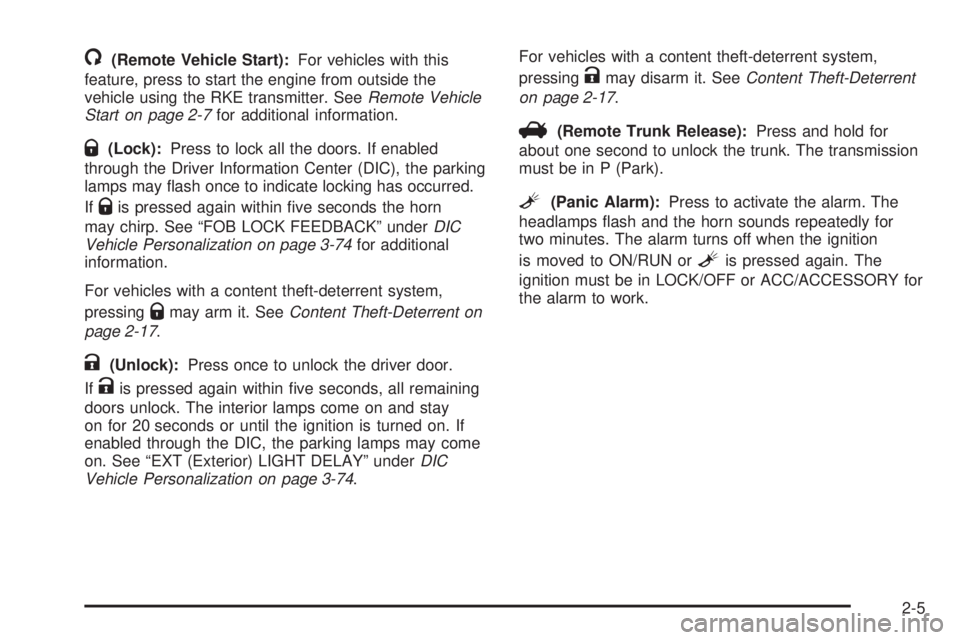
/(Remote Vehicle Start):For vehicles with this
feature, press to start the engine from outside the
vehicle using the RKE transmitter. SeeRemote Vehicle
Start on page 2-7for additional information.
Q(Lock):Press to lock all the doors. If enabled
through the Driver Information Center (DIC), the parking
lamps may �ash once to indicate locking has occurred.
If
Qis pressed again within �ve seconds the horn
may chirp. See “FOB LOCK FEEDBACK” underDIC
Vehicle Personalization on page 3-74for additional
information.
For vehicles with a content theft-deterrent system,
pressing
Qmay arm it. SeeContent Theft-Deterrent on
page 2-17.
K(Unlock):Press once to unlock the driver door.
If
Kis pressed again within �ve seconds, all remaining
doors unlock. The interior lamps come on and stay
on for 20 seconds or until the ignition is turned on. If
enabled through the DIC, the parking lamps may come
on. See “EXT (Exterior) LIGHT DELAY” underDIC
Vehicle Personalization on page 3-74.For vehicles with a content theft-deterrent system,
pressing
Kmay disarm it. SeeContent Theft-Deterrent
on page 2-17.
V(Remote Trunk Release):Press and hold for
about one second to unlock the trunk. The transmission
must be in P (Park).
L(Panic Alarm):Press to activate the alarm. The
headlamps �ash and the horn sounds repeatedly for
two minutes. The alarm turns off when the ignition
is moved to ON/RUN or
Lis pressed again. The
ignition must be in LOCK/OFF or ACC/ACCESSORY for
the alarm to work.
2-5
Page 81 of 428

Remote Vehicle Start
Your vehicle may have a remote starting feature that
allows you to start the engine from outside the vehicle.
It may also start the vehicle’s heating or air conditioning
systems and rear window defogger. When the remote
start system is active and the vehicle has an automatic
climate control system, it will automatically regulate
the inside temperature. Normal operation of these
systems will return after the ignition key is turned to
ON/RUN.
Laws in some communities may restrict the use of
remote starters. For example, some laws may require a
person using remote start to have the vehicle in view
when doing so. Check local regulations for any
requirements on remote starting of vehicles.
Do not use the remote start feature if your vehicle
is low on fuel. Your vehicle may run out of fuel.
If your vehicle has the remote start feature, the RKE
transmitter functions will have an increased range
of operation. However, the range may be less while the
vehicle is running.
There are other conditions which can affect the
performance of the transmitter, seeRemote Keyless
Entry (RKE) System on page 2-3for additional
information.
/(Remote Start):This button will be on the RKE
transmitter if you have remote start.
To start the vehicle using the remote start feature:
1. Aim the transmitter at the vehicle.
2. Press and release the transmitter’s lock button,
then immediately press and hold the transmitter’s
remote start button for about four seconds or
until the vehicle’s turn signal lamps �ash. The doors
will lock.
When the vehicle starts, the parking lamps turn on
and remain on while the engine is running.
The remote start feature provides two separate starts
per ignition cycle, each with 10 minutes of engine
running time, or one start with a time extension. The
�rst start must expire or be canceled to get two separate
10 minute starts.
If it is the �rst remote start since the vehicle has been
driven, repeat the previous steps, while the engine is still
running, to extend the engine running time by 10 minutes
from the time you repeat the steps for remote starting.
The remote start running time can be extended one time
and only after the �rst remote start.
After entering the vehicle during a remote start, insert
and turn the key to ON/RUN to drive the vehicle.
2-7
Page 82 of 428
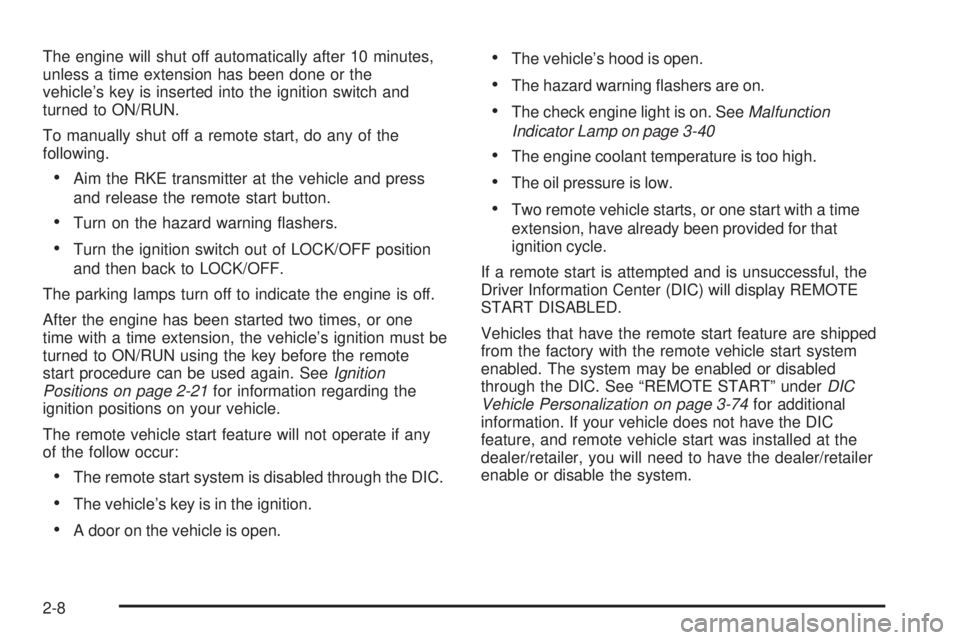
The engine will shut off automatically after 10 minutes,
unless a time extension has been done or the
vehicle’s key is inserted into the ignition switch and
turned to ON/RUN.
To manually shut off a remote start, do any of the
following.
Aim the RKE transmitter at the vehicle and press
and release the remote start button.
Turn on the hazard warning �ashers.
Turn the ignition switch out of LOCK/OFF position
and then back to LOCK/OFF.
The parking lamps turn off to indicate the engine is off.
After the engine has been started two times, or one
time with a time extension, the vehicle’s ignition must be
turned to ON/RUN using the key before the remote
start procedure can be used again. SeeIgnition
Positions on page 2-21for information regarding the
ignition positions on your vehicle.
The remote vehicle start feature will not operate if any
of the follow occur:
The remote start system is disabled through the DIC.
The vehicle’s key is in the ignition.
A door on the vehicle is open.
The vehicle’s hood is open.
The hazard warning �ashers are on.
The check engine light is on. SeeMalfunction
Indicator Lamp on page 3-40
The engine coolant temperature is too high.
The oil pressure is low.
Two remote vehicle starts, or one start with a time
extension, have already been provided for that
ignition cycle.
If a remote start is attempted and is unsuccessful, the
Driver Information Center (DIC) will display REMOTE
START DISABLED.
Vehicles that have the remote start feature are shipped
from the factory with the remote vehicle start system
enabled. The system may be enabled or disabled
through the DIC. See “REMOTE START” underDIC
Vehicle Personalization on page 3-74for additional
information. If your vehicle does not have the DIC
feature, and remote vehicle start was installed at the
dealer/retailer, you will need to have the dealer/retailer
enable or disable the system.
2-8
Page 127 of 428
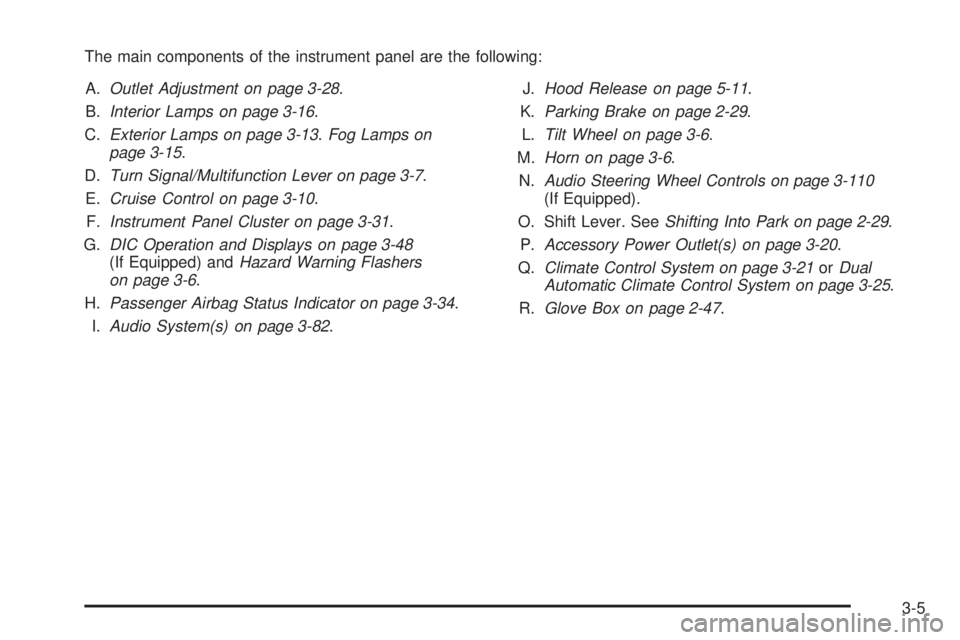
The main components of the instrument panel are the following:
A.Outlet Adjustment on page 3-28.
B.Interior Lamps on page 3-16.
C.Exterior Lamps on page 3-13.Fog Lamps on
page 3-15.
D.Turn Signal/Multifunction Lever on page 3-7.
E.Cruise Control on page 3-10.
F.Instrument Panel Cluster on page 3-31.
G.DIC Operation and Displays on page 3-48
(If Equipped) andHazard Warning Flashers
on page 3-6.
H.Passenger Airbag Status Indicator on page 3-34.
I.Audio System(s) on page 3-82.J.Hood Release on page 5-11.
K.Parking Brake on page 2-29.
L.Tilt Wheel on page 3-6.
M.Horn on page 3-6.
N.Audio Steering Wheel Controls on page 3-110
(If Equipped).
O. Shift Lever. SeeShifting Into Park on page 2-29.
P.Accessory Power Outlet(s) on page 3-20.
Q.Climate Control System on page 3-21orDual
Automatic Climate Control System on page 3-25.
R.Glove Box on page 2-47.
3-5
Page 135 of 428
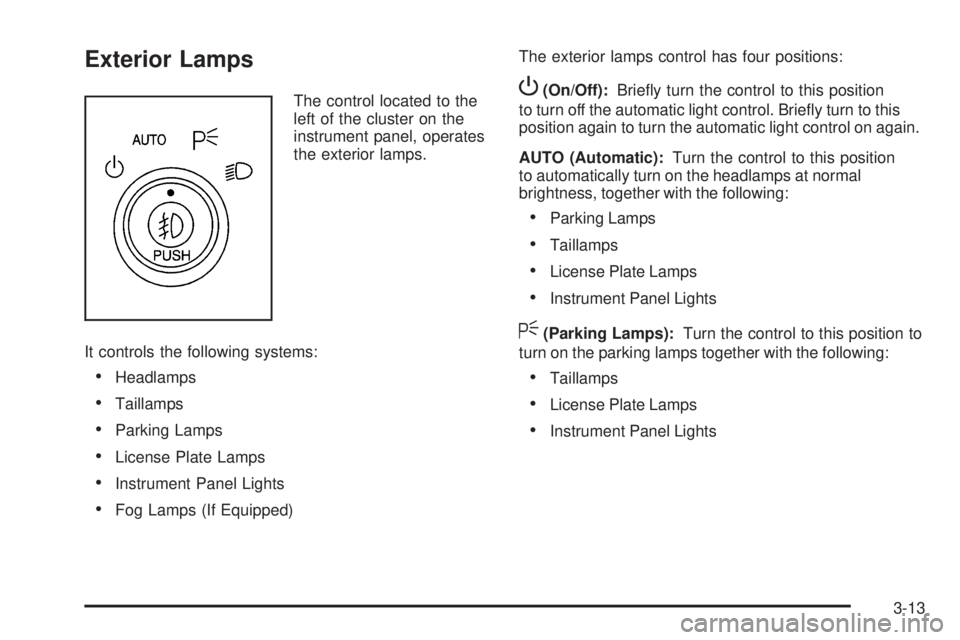
Exterior Lamps
The control located to the
left of the cluster on the
instrument panel, operates
the exterior lamps.
It controls the following systems:
Headlamps
Taillamps
Parking Lamps
License Plate Lamps
Instrument Panel Lights
Fog Lamps (If Equipped)The exterior lamps control has four positions:
P(On/Off):Brie�y turn the control to this position
to turn off the automatic light control. Brie�y turn to this
position again to turn the automatic light control on again.
AUTO (Automatic):Turn the control to this position
to automatically turn on the headlamps at normal
brightness, together with the following:
Parking Lamps
Taillamps
License Plate Lamps
Instrument Panel Lights
<(Parking Lamps):Turn the control to this position to
turn on the parking lamps together with the following:
Taillamps
License Plate Lamps
Instrument Panel Lights
3-13
Page 136 of 428
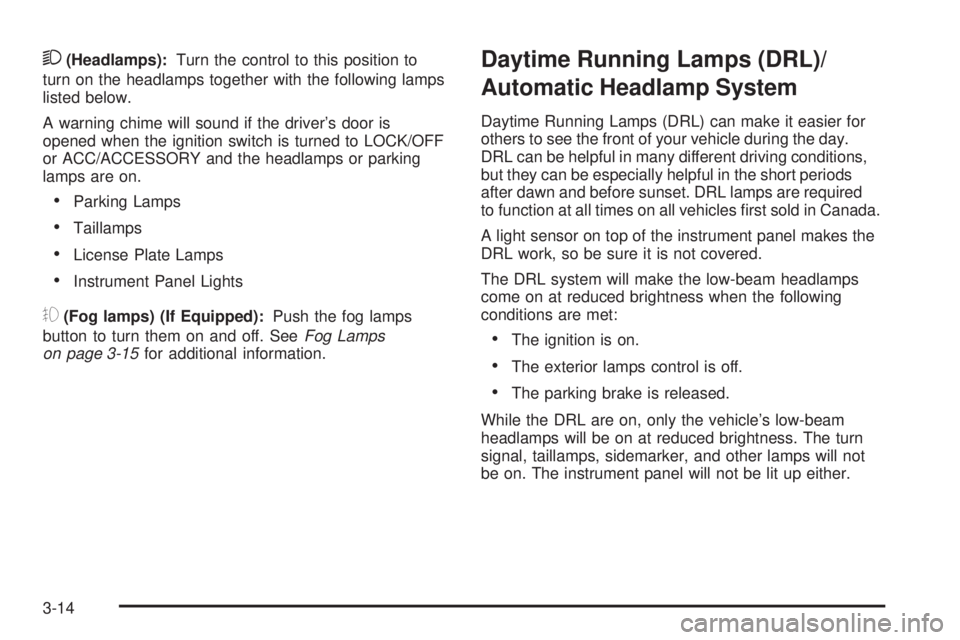
2(Headlamps):Turn the control to this position to
turn on the headlamps together with the following lamps
listed below.
A warning chime will sound if the driver’s door is
opened when the ignition switch is turned to LOCK/OFF
or ACC/ACCESSORY and the headlamps or parking
lamps are on.
Parking Lamps
Taillamps
License Plate Lamps
Instrument Panel Lights
#(Fog lamps) (If Equipped):Push the fog lamps
button to turn them on and off. SeeFog Lamps
on page 3-15for additional information.
Daytime Running Lamps (DRL)/
Automatic Headlamp System
Daytime Running Lamps (DRL) can make it easier for
others to see the front of your vehicle during the day.
DRL can be helpful in many different driving conditions,
but they can be especially helpful in the short periods
after dawn and before sunset. DRL lamps are required
to function at all times on all vehicles �rst sold in Canada.
A light sensor on top of the instrument panel makes the
DRL work, so be sure it is not covered.
The DRL system will make the low-beam headlamps
come on at reduced brightness when the following
conditions are met:
The ignition is on.
The exterior lamps control is off.
The parking brake is released.
While the DRL are on, only the vehicle’s low-beam
headlamps will be on at reduced brightness. The turn
signal, taillamps, sidemarker, and other lamps will not
be on. The instrument panel will not be lit up either.
3-14
Page 137 of 428
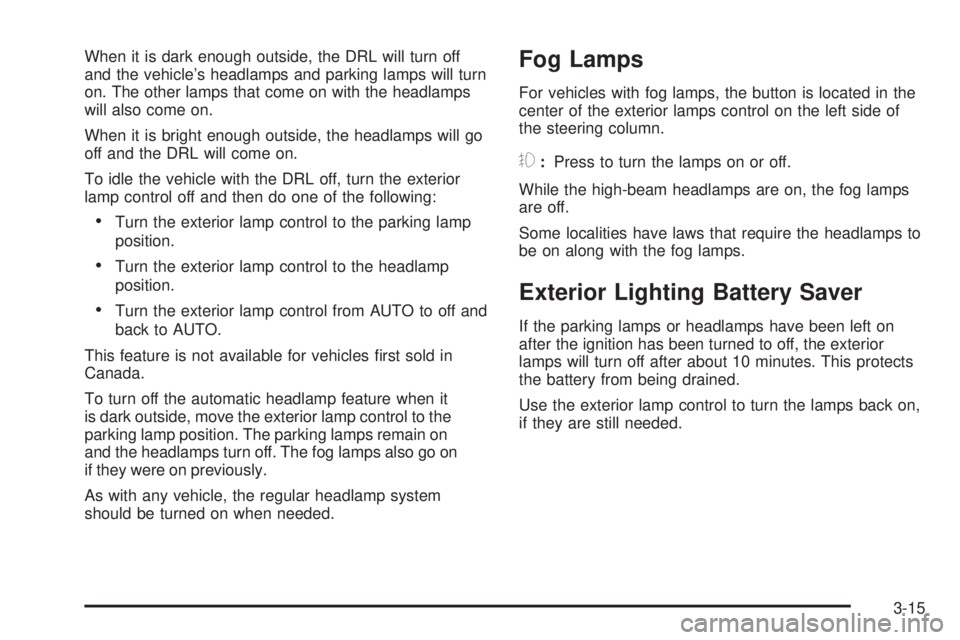
When it is dark enough outside, the DRL will turn off
and the vehicle’s headlamps and parking lamps will turn
on. The other lamps that come on with the headlamps
will also come on.
When it is bright enough outside, the headlamps will go
off and the DRL will come on.
To idle the vehicle with the DRL off, turn the exterior
lamp control off and then do one of the following:
Turn the exterior lamp control to the parking lamp
position.
Turn the exterior lamp control to the headlamp
position.
Turn the exterior lamp control from AUTO to off and
back to AUTO.
This feature is not available for vehicles �rst sold in
Canada.
To turn off the automatic headlamp feature when it
is dark outside, move the exterior lamp control to the
parking lamp position. The parking lamps remain on
and the headlamps turn off. The fog lamps also go on
if they were on previously.
As with any vehicle, the regular headlamp system
should be turned on when needed.
Fog Lamps
For vehicles with fog lamps, the button is located in the
center of the exterior lamps control on the left side of
the steering column.
#:Press to turn the lamps on or off.
While the high-beam headlamps are on, the fog lamps
are off.
Some localities have laws that require the headlamps to
be on along with the fog lamps.
Exterior Lighting Battery Saver
If the parking lamps or headlamps have been left on
after the ignition has been turned to off, the exterior
lamps will turn off after about 10 minutes. This protects
the battery from being drained.
Use the exterior lamp control to turn the lamps back on,
if they are still needed.
3-15
Page 182 of 428

ENGINE COOLANT HOT
Notice:If you drive your vehicle while the engine is
overheating, severe engine damage may occur. If an
overheat warning appears on the instrument panel
cluster and/or DIC, stop the vehicle as soon as
possible. Do not increase the engine speed above
normal idling speed. SeeEngine Overheating on
page 5-31for more information.
This message displays when the engine coolant
temperature is too hot. The engine coolant temperature
warning light also appears on the instrument panel
cluster. SeeEngine Coolant Temperature Warning
Light on page 3-38andEngine Coolant Temperature
Gage on page 3-38for more information.
To avoid added strain on the engine, turn off the air
conditioner if it is on. When the coolant temperature
returns to normal, the air conditioner can be turned
back on.
This message displays only when the ignition is in
ON/RUN. A chime sounds continuously when this
message is displayed. Press any of the DIC buttons
to acknowledge this message and to clear it from the
screen.This message continues to display for two seconds
if it has not been acknowledged when the engine
is turned off. It also re-displays for two seconds if the
message has been acknowledged, but the condition
still exists when the engine is turned off.
If the condition still exists, the message re-appears
when the engine is turned on.
HEADLAMPS SUGGESTED
This message displays when the amount of available
light outside of the vehicle is low, or the windshield
wipers have been on for about 30 seconds, and
the exterior lamps control is off or in the parking lamps
position. This message informs the driver that turning
on the exterior lamps is recommended. SeeExterior
Lamps on page 3-13for more information.
This message displays while the ignition is in ON/RUN.
Press any of the DIC buttons to acknowledge this
message and to clear it from the screen.
This message continues to display for two seconds
if it has not been acknowledged when the engine
is turned off. It also re-displays for two seconds if the
message has been acknowledged, but the condition
still exists when the engine is turned off.
If the condition still exists, the message re-appears
when the engine is turned on.
3-60
Page 187 of 428
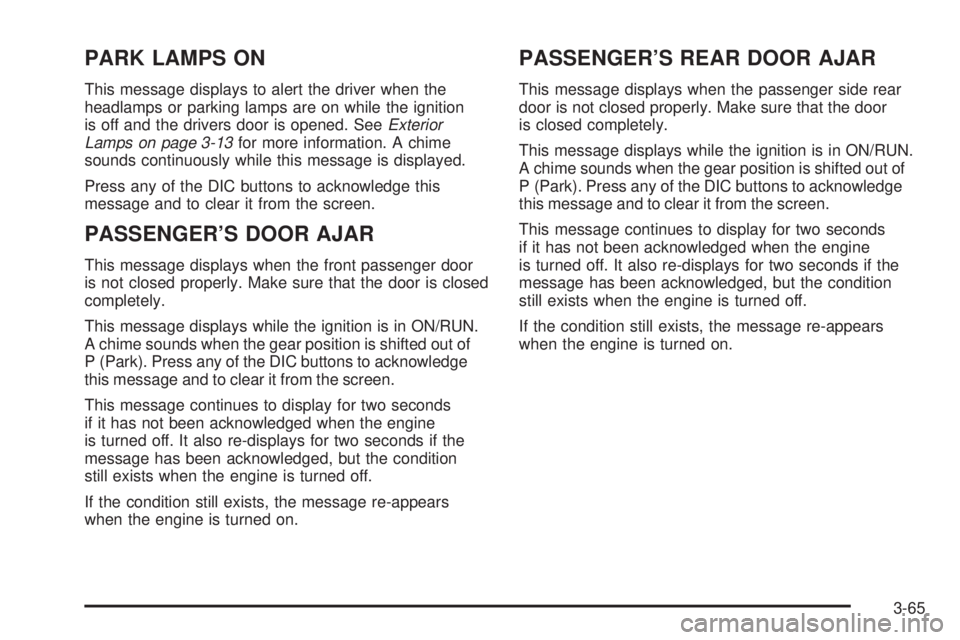
PARK LAMPS ON
This message displays to alert the driver when the
headlamps or parking lamps are on while the ignition
is off and the drivers door is opened. SeeExterior
Lamps on page 3-13for more information. A chime
sounds continuously while this message is displayed.
Press any of the DIC buttons to acknowledge this
message and to clear it from the screen.
PASSENGER’S DOOR AJAR
This message displays when the front passenger door
is not closed properly. Make sure that the door is closed
completely.
This message displays while the ignition is in ON/RUN.
A chime sounds when the gear position is shifted out of
P (Park). Press any of the DIC buttons to acknowledge
this message and to clear it from the screen.
This message continues to display for two seconds
if it has not been acknowledged when the engine
is turned off. It also re-displays for two seconds if the
message has been acknowledged, but the condition
still exists when the engine is turned off.
If the condition still exists, the message re-appears
when the engine is turned on.
PASSENGER’S REAR DOOR AJAR
This message displays when the passenger side rear
door is not closed properly. Make sure that the door
is closed completely.
This message displays while the ignition is in ON/RUN.
A chime sounds when the gear position is shifted out of
P (Park). Press any of the DIC buttons to acknowledge
this message and to clear it from the screen.
This message continues to display for two seconds
if it has not been acknowledged when the engine
is turned off. It also re-displays for two seconds if the
message has been acknowledged, but the condition
still exists when the engine is turned off.
If the condition still exists, the message re-appears
when the engine is turned on.
3-65
Page 263 of 428
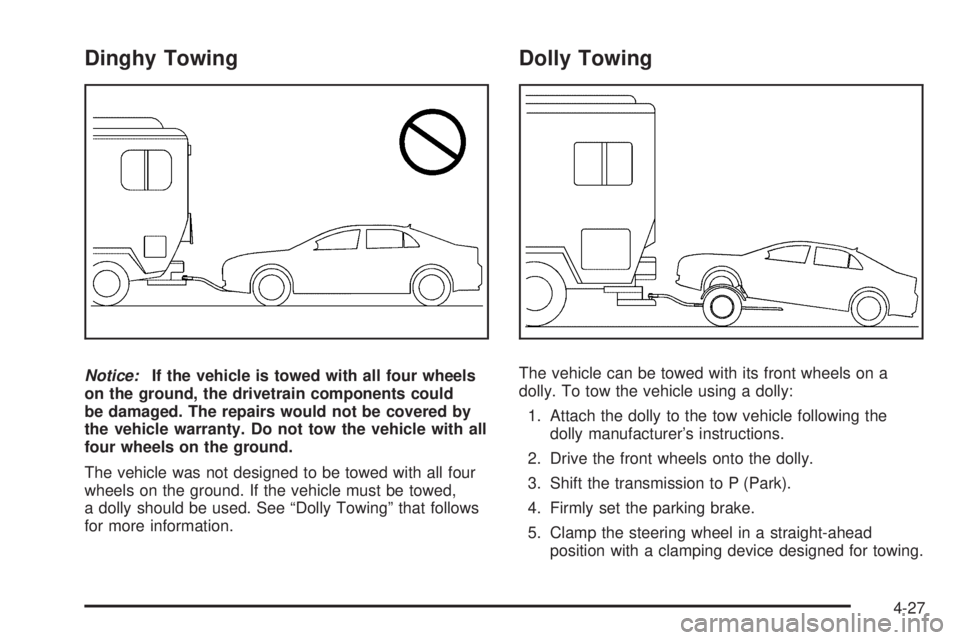
Dinghy Towing
Notice:If the vehicle is towed with all four wheels
on the ground, the drivetrain components could
be damaged. The repairs would not be covered by
the vehicle warranty. Do not tow the vehicle with all
four wheels on the ground.
The vehicle was not designed to be towed with all four
wheels on the ground. If the vehicle must be towed,
a dolly should be used. See “Dolly Towing” that follows
for more information.
Dolly Towing
The vehicle can be towed with its front wheels on a
dolly. To tow the vehicle using a dolly:
1. Attach the dolly to the tow vehicle following the
dolly manufacturer’s instructions.
2. Drive the front wheels onto the dolly.
3. Shift the transmission to P (Park).
4. Firmly set the parking brake.
5. Clamp the steering wheel in a straight-ahead
position with a clamping device designed for towing.
4-27